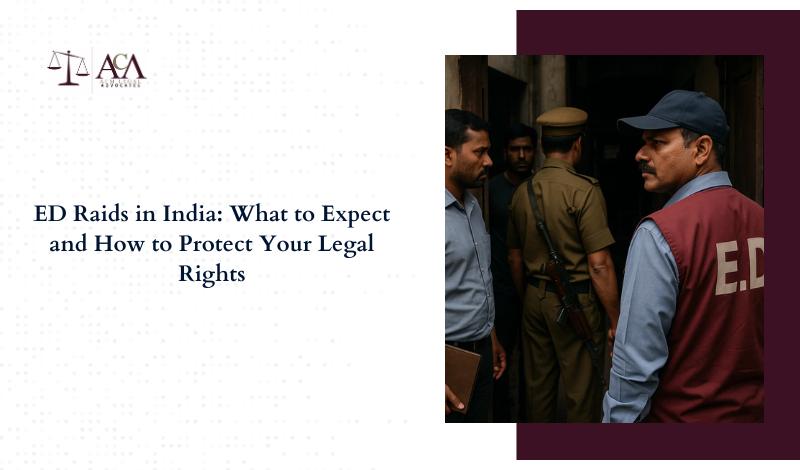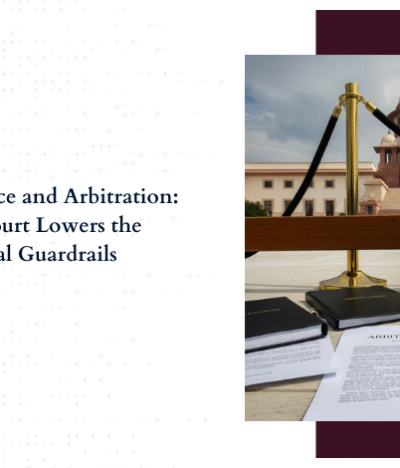In India, Enforcement Directorate (ED) raids are frequently in the spotlight due to their use in probing financial and foreign exchange offences under laws like the PMLA (Prevention of Money Laundering Act, 2002) and FEMA (Foreign Exchange Management Act, 1999). Media coverage and public debates have sparked growing concerns over due process, human rights, and legal safeguards.
This article delves into:
- What happens during an ED raid: From issuance of notices and search warrants to seizure of property, digital assets, and personal questioning.
- How to protect your rights: Legal strategies ranging from assertion of privilege to seeking judicial oversight.
- Post-raid remedies: Including challenges to seizure, release of assets, and compensation for rights violations.
Key questions answered:
- What powers does ED have during a raid?
- How to handle summons and ensure legal compliance?
- What are your constitutional, procedural, and evidentiary protections?
- How to regain control if your property is attached or seized?
Legal Basis for ED Raids: Powers under PMLA and FEMA
The Enforcement Directorate (ED) derives its search and seizure powers primarily from two statutes:
A. Prevention of Money Laundering Act, 2002 (PMLA)
Under Section 17 of the PMLA, the ED is empowered to:
- Conduct searches at premises if there is “reason to believe” that proceeds of crime are located there.
- Seize property, documents, and records relevant to the investigation.
- Search individuals physically if required.
The ED must record its “reason to believe” in writing, and such reasons must be produced before the Adjudicating Authority under PMLA within 30 days of the seizure.
B. Foreign Exchange Management Act, 1999 (FEMA)
Under Section 37 of FEMA, the ED is authorised to:
- Conduct investigations for contraventions of foreign exchange laws.
- Issue summons, examine persons under oath, and compel production of documents.
While FEMA is a civil economic legislation, violations often trigger parallel action under PMLA or the Income Tax Act where criminality is suspected.
C. Relevant Procedural Laws
- Section 103–105 CrPC (Code of Criminal Procedure, 1973): Guides the conduct of search and seizure operations.
- Article 20(3) and Article 21 of the Constitution: Protect individuals from self-incrimination and ensure due process during raids.
The ED functions as an investigative agency, not a judicial authority. Hence, its actions must conform to principles of fairness, transparency, and legality as laid down by Indian courts.
What Happens During an ED Raid: Step-by-Step Procedure

Understanding the standard procedure of an ED raid helps in ensuring that your rights are not violated during the search. Here’s how a typical ED raid unfolds:
A. Arrival and Identification
- ED officials must arrive with a valid search warrant issued under Section 17 of the PMLA or Section 37 of FEMA.
- Officers are required to identify themselves and disclose the purpose of the search to the person in possession of the premises.
B. Presence of Independent Witnesses
- As per the CrPC, at least two independent witnesses (typically local residents) must be present during the search.
- This ensures that the raid is conducted in a fair and transparent manner.
C. Search and Seizure Process
- The ED may search premises, lockers, digital devices, and other assets believed to be connected with proceeds of crime.
- Electronic evidence such as mobile phones, laptops, and emails may be cloned or confiscated.
- Personal searches of individuals can also be carried out in the presence of witnesses.
D. Seizure Memo and Panchnama
- All seized items are to be listed and documented in a seizure memo (also known as panchnama), signed by the ED officer, the person searched, and the witnesses.
- A copy of the panchnama must be provided to the person from whose possession the articles were seized.
E. Summons for Statement
- The ED may summon the concerned individuals under Section 50 of the PMLA for recording statements under oath.
- Failure to attend or misleading the authorities may lead to arrest or prosecution.
F. Post-Raid Formalities
- The ED must submit a report to the Adjudicating Authority within 30 days of the raid.
- The seized property may be provisionally attached and confirmed later through quasi-judicial proceedings.
A person subjected to a raid is not under arrest unless a formal arrest memo is issued. However, their cooperation is legally expected during the search.
Legal Rights During an ED Raid: What You Can Lawfully Assert
While the ED has wide investigative powers, individuals and businesses are not powerless. Indian law provides a range of procedural and constitutional protections that can be asserted during a raid to ensure fairness and prevent abuse.
A. Right to Legal Representation
- Although lawyers are not allowed to intervene during the raid, you may:
- Request to consult your lawyer, especially before making written or signed statements.
- Insist that any questioning under oath be done with an opportunity to seek legal advice.
- Request to consult your lawyer, especially before making written or signed statements.
B. Right Against Self-Incrimination
- Under Article 20(3) of the Constitution, you have the right not to answer questions that may incriminate you.
- However, you are obligated to cooperate and produce documents if demanded lawfully.
C. Right to Receive Copy of Seizure Memo
- Insist on a complete, itemised seizure list (panchnama) and verify its contents before signing.
- You may note objections or discrepancies in writing before signing any document.
D. Right to Humane and Respectful Treatment
- The raid must be conducted during reasonable daytime hours, unless exceptional circumstances exist.
- Personal dignity, especially of women or elderly persons, must be respected as per judicial precedents.
- Any form of coercion, threats, or physical harm is illegal and actionable under criminal and human rights law.
E. Right to File Representation or Objection
- You may file objections with the Adjudicating Authority under PMLA within 30 days challenging the legality of the seizure or search.
- You can also approach the High Court under Article 226 for violation of fundamental rights or unlawful searches.
F. Right to Digital Privacy
- Seizure of digital devices must be proportionate and specific. Blanket seizure or access to entire devices without limit has been questioned by courts.
- Passwords or encryption keys need not be shared unless ordered by a competent court.
How to respond to an ED summons
Post-Raid Remedies and Legal Strategy
After an ED raid, swift and strategic legal action is crucial to minimise reputational, financial, and procedural damage. Indian law offers multiple remedies to challenge illegal searches, reclaim seized assets, and defend against coercive proceedings.
A. Filing Objections Before Adjudicating Authority
- Under Section 8 of the PMLA, a person aggrieved by the seizure or attachment must be issued a notice.
- You have the right to file a detailed objection and present documentary evidence to prove that the seized property is not “proceeds of crime”.
- Legal representation is permitted, and cross-examination of ED officers can be requested in some cases.
B. Approach the High Court under Article 226
- If the search was malafide, disproportionate, or conducted without valid authority, a writ petition can be filed before the High Court seeking:
- Quashing of the raid or seizure proceedings.
- Directions for return of property.
- Compensation for violation of fundamental rights.
- Quashing of the raid or seizure proceedings.
C. Bail and Anticipatory Bail
- If custodial interrogation is anticipated, individuals can file for anticipatory bail under Section 438 CrPC.
- Bail may also be sought post-arrest, especially if ED claims non-cooperation or if summons were defied.
D. Filing a Complaint with NHRC or SHRC
- If human rights were violated (e.g., illegal detention, use of force), you may file a complaint before the National or State Human Rights Commission.
E. Challenging Digital Seizure and Privacy Violations
- If electronic devices are seized without proper warrant or legal authority, representation under Information Technology laws and constitutional petitions may be filed.
F. Reputation Management
- ED raids often attract media scrutiny. Engage a legal professional to:
- Draft appropriate press statements if necessary.
- Prevent trial by media or misreporting that could prejudice your case.
- Draft appropriate press statements if necessary.
Conclusion
An ED raid can be a legally disruptive and emotionally taxing experience. However, Indian jurisprudence balances investigative powers with strong procedural safeguards. Knowing your rights, consulting a legal expert early, and responding with calm and strategic clarity can protect your interests effectively.
Frequently Asked Questions
Q1: What happens in an ED raid in India?
ED officials search premises, seize evidence, and record statements under PMLA or FEMA with witnesses present. A seizure memo is prepared, and digital or physical assets may be taken.
Q2: Can the ED seize my digital devices?
Yes, ED can seize digital devices if they believe they contain evidence of money laundering. However, the seizure must be recorded and justified under law.
Q3: What are my rights during an ED search?
You have the right to legal counsel, protection against self-incrimination, respectful treatment, and a copy of the seizure memo. You may object to any illegal actions.
Q4: Can I challenge the raid in High Court?
Yes, you can file a writ petition under Article 226 if the raid violates your fundamental or procedural rights.
Q5: How long can the ED keep seized assets?
Seized assets can be kept up to 180 days, subject to confirmation by the Adjudicating Authority under PMLA.






